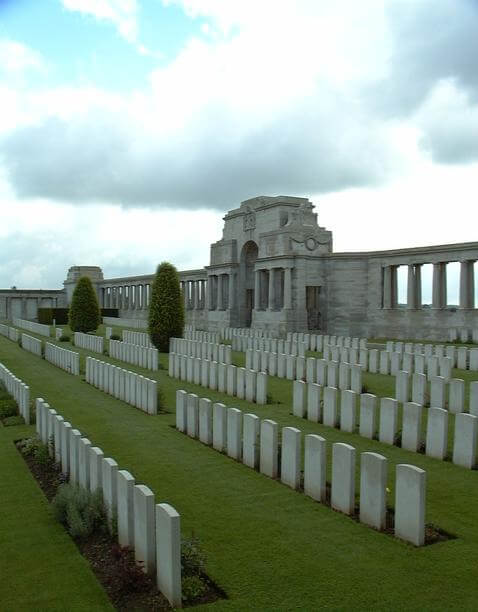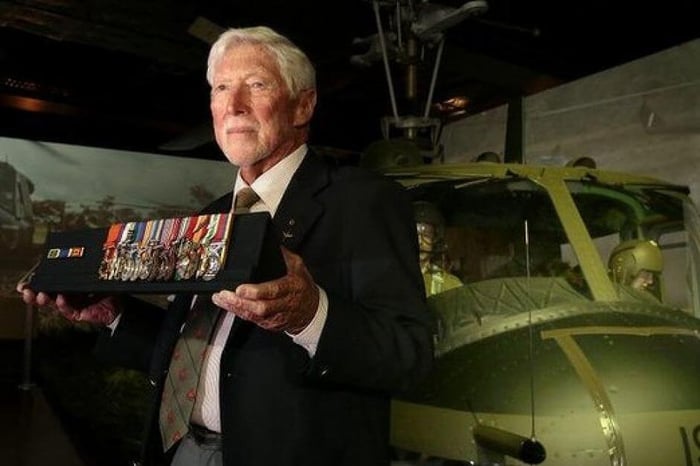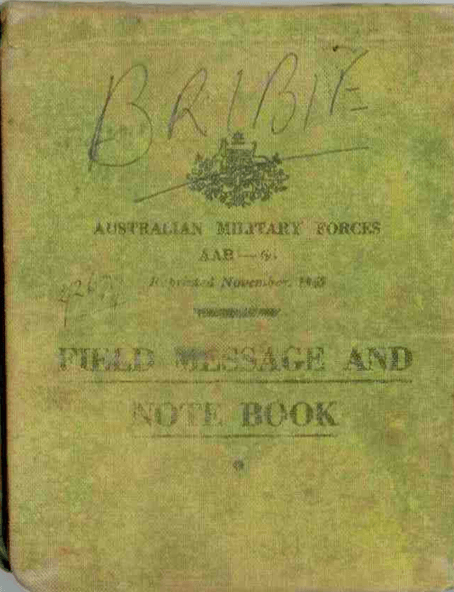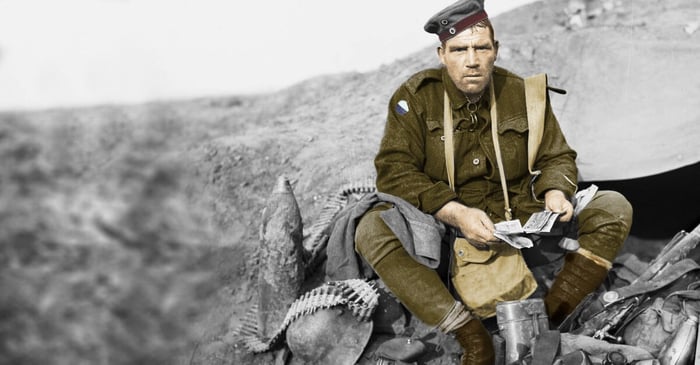
The Unknown Soldier
We do not know this Australian’s name and we never will. We do not know his rank or battalion. We do not know where he was born, or precisely how and when he died. We do not know where in Australia he had made his home or when he left it for the battlefields of Europe. We do not know his age or his circumstances, whether he was from the city or the bush, what occupation he left to become a soldier, what religion, if he had a religion, if he was married or single. We do not know who loved him or whom he loved. If he had children we do not know who they are. His family is lost to us as he was lost to them. We will never know who this Australian was.
Yet he has always been among those we have honoured. We know that he was one of the 45,000 Australian’s who died on the Western Front. One of the 416,000 Australian’s who volunteered for service in the Great War. One of the 324,000 Australian’s who served overseas in that war, and one of the 60,000 Australian’s who died on foreign soil. One of the 100,000 Australian’s who have died in wars this century.
He is all of them. And he is one of us. This Australia and the Australia he knew are like foreign countries. The tide of events since he died has been so dramatic, so vast and all consuming, a world has been created beyond the reach of his imagination. He may have been one of those who believed the Great War would be an adventure to grand to miss. He may have felt that he would never live down the shame of not going. But the chances are that he went for no other reason than that he believed it was his duty, the duty he owed his country and his King.
Because the Great War was a mad, brutal, awful struggle distinguished more often than not by military and political incompetence, because the waste of human life was so terrible that some said victory was scarcely discernible form defeat, and because the war which was supposed to end all wars in fact sowed the seeds of a second, even more terrible, war, we might think that this Unknown Soldier died in vain.
But in honouring our war dead as we always have, we declare that this is not true. For out of the war came a lesson which transcended the horror and tragedy and the inexcusable folly. It was a lesson about ordinary people, and the lesson was that they were not ordinary.
On all sides they were the heroes of the war, not the generals and the politicians, but the soldiers and sailors, and nurses, those who taught us to endure hardship, show courage, to be bold as well as resilient, to believe in ourselves, to stick together. The Unknown Australian Soldier we inter today was one of those who by his deeds proved that real nobility and grandeur belongs not to empires and nations but to the very people on whom they, in the last resort, always depend.
That is surely at the heart of the Anzac story, the Australian legend which emerged from the war. It is a legend not of sweeping military victories so much as triumphs against the odds, of courage and ingenuity in adversity. It is a legend of free and independent spirits whose discipline derived less from military formalities and customs than from the bonds of mate-ship and the demands of necessity.
It is a national tradition, the tradition in which Australian’s have gone to war ever since. The Unknown Australian is not interred here to glorify war over peace, or to assert a soldier’s character above a civilian’s, or one race or one nation or one religion above another, or men above women, or the war in which he fought and died above any other war, or of one generation above any that has or will come later.
The Unknown Soldier honours the memory of all those men and women whom laid down their lives for Australia. His tomb is a reminder of what we have lost in war and what we have gained. We have lost more than 100,000 lives, and with them all their love of this country and all their hope and energy. We have gained a legend, a story of bravery and sacrifice and with it a deeper faith in ourselves and our democracy, and a deeper understanding of what it means to be Australian.
It is not too much to hope, therefore, that this Unknown Australian soldier might continue to serve his country, he might enshrine a nation’s love of peace and remind us that in the sacrifice of the men and women whose names are recorded here there is faith enough for all of us.
And so, with those words from the then Prime Minister of Australia, Mr Paul Keating, Australia’s Unknown Soldier was finally laid to rest at The Australian War Memorial, on Armistice Day, the 11th of November 1993.
I, along with countless other Australian’s watched the live broadcast on TV. The service was very dignified and very moving. As I watched the Unknown Soldier laid to rest I could not help thinking this had more to do with somebody wanting to score political brownie points rather than honouring our countries Great War dead. Don’t get me wrong, the idea behind an Unknown Soldier is to be commended but in my humble opinion his internment here in Australia was 70 years too late! Call me cynical if you will but in this the 21st century and the age of DNA where they can identify someone from a single hair the term unknown soldier just does not have the same mysticism and meaning as it did in the 1920’s!
Take the American Unknown Soldier from the Vietnam War for example, from memory they are up to number 3 as they keep identifying them which upsets the phrase somewhat, “Known only unto God.” Allow me to elaborate by starting with the circumstances surrounding the origin of the Original Unknown Soldier.
In 1916 the Reverend David Railton was serving as a chaplain to British forces at the front in France. In a garden at Armentierés one day he noticed a make-shift grave marked by a rough wooden cross across which was written "An Unknown British Soldier". The sight was not lost on him and four years later he wrote to the Dean of Westminster to convey a remembrance of that scene. Dean Ryle recognised the message spoken by that grave in France and became the leading force that resulted in the Tomb of the Unknown Soldier of Great Britain.
On the 11 November 1919, the first anniversary of the Armistice, Great Britain had paused for two minutes of silence to remember the dead. Nearly three quarters of a million soldiers were cut down on the battle fields of France, Belgium, Palestine, Gallipoli and elsewhere during the Great War. The War to End all Wars as it was known then, had left almost no British family not grieving in one way or another.
In the streets of Whitehall, under the direction of Sir Edward Lutyen’s, the great Cenotaph to honour the Great War dead, was taking shape. It was beautifully designed, beautifully constructed and more than adequate as a symbol and gathering point for the countries living to pay respect to a generation all but lost, but the ache in the hearts of the British people wanted more, not so much in the way of monuments, they were scattered in most towns and cities across the empire, but something more personal.
Early in October 1920, the then Dean of Westminster, Dean Ryle, gave voice to that longing in a letter forwarded to Buckingham Palace. The Dean suggested that the body of an unidentified soldier should be dug up, brought to England and buried in Westminster Abbey. Without class, rank or name, this man would be the silent ambassador for the dead among the living.
King George V was at first aghast at the proposal. It was, for a start, novel and therefore unwelcome, it was also, and almost everyone agreed on this point, poised on the tightrope of taste. Dean Ryle persisted, however, and recruited an all important ally in the then Prime Minister of Britain, David Lloyd-George. Lord Curzon was placed in charge of the cabinet committee that would oversee the operation. Haste was of the essence.
In the weak sunlight of the 8th of November 1920, six small working parties, each carrying a stretcher and a Union Jack, set out for six of the war’s main battlefields. They were under strict orders to exhume a British body buried under a cross marked “unknown” from the battlefields of Ypres, Cambrai, the Somme, the Aisne, the Marne and Arras. The bodies were laid, with due care and attention upon the stretcher’s and covered with the flag of Great Britain and then taken by ambulance to a hut that had been prepared earlier on the outskirts of the Belgian City of Ypres where the selection was to be made.
The stretcher’s, with their precious cargo in place, were carefully placed inside the hut and a British officer was led blindfolded into the room. Hesitantly, with his arms outstretched, he shuffled around the room. Eventually his hands touched one of the flag shrouded stretcher’s. The officer’s job was done! Helpers removed the blindfold from his eyes and then all looked on in awe at what chance had wrought. Their, in the fading late Autumn light lay the remains of Britain’s Unknown Soldier.
On the morning of November the 9th, a service was held to commemorate the sacrifice of the Unknown Soldier, officiated by chaplains from the Church of England, the Roman Catholic Church, and the Non-Conformist Churches. The flag shrouded stretcher was then placed onto a French military wagon, drawn by six black horses. At 10.30 am, all the church bells of Boulogne tolled; the massed trumpets of the French cavalry and the bugles of the French infantry played the "Last Post". Then, the mile-long procession, led by one thousand local schoolchildren and escorted by a division of French troops, made its way down to the harbour.
The ceremony had just begun. Eight soldiers, only one of them with rank higher than a Sergeant and including an Australian private, accompanied the body to Boulogne. A destroyer, the HMS Verdun, was waiting at the Quay. It had brought a great coffin, made of oak from a tree at Hampton Court Palace and embellished in ancient iron-work, it was designed and built by the British Undertakers Association. With great care and humility the remains were taken from the stretcher and placed in the waiting coffin. King George V, who was now absorbed by the idea, had selected an ancient sword from his private collection and had it clipped to the top of the coffin.
Half-way across the Channel, HMS Verdun was joined by six other destroyers. They wheeled in behind her stern and escorted the ship and its precious cargo into harbour, where the guns of Dover Castle fired 19 times in a Field Marshal’s salute. From Dover, six warrant officers from the Royal Navy, Royal Marines, Royal Air Force and Royal Army then bore the coffin home to British soil, the coffin was then transferred to a special train and taken to London, where it rested overnight in a temporary chapel at Victoria Station.
Crowds gathered at every station on the way as the Unknown Warrior's train travelled north from the Kent coast to London's Victoria station. The train thundered through the dark, wet, moonless night. At the platforms by which it rushed could be seen groups of women watching and silent, many dressed in deep mourning. Many an upper window was open and against the golden square of light was silhouetted clear cut and black the head and shoulders of some faithful watcher, In the London suburbs there were scores of homes with back doors flung wide, light flooding out and in the garden figures of men women and children gazing at the great lighted train rushing past.
On the morning of November the 11th, Armistice Day, six black horses drew the gun carriage that now bore the Unknown Soldier through London's crowd-lined streets, escorted by five Admiral’s, four Field marshal’s, two General’s and the RAF’s lone Air Marshal; pausing at The Mall, Whitehall, where the Cenotaph was unveiled by King George V. The King, his three sons, members of the Royal Family and Ministers of State then followed the coffin through the streets to the north entrance of Westminster Abbey.
On arrival at Westminster the Unknown Soldier was greeted by one hundred uniformed Victoria Cross winners, who formed a guard of honour lined up each side of the naive and, as a historian put it, “the King and his family crowded around the coffin as though it literally did contain a son and a brother. The King’s wreath bore a card affectionately crammed with his own scratchy, handwriting. It was the moment of truth.”
The service was brief, impressive and touching. The guests of honour at the service were approximately 100 women who sat quietly in the congregation, each one an invited guest, each one had lost both their husband and all their sons in the Great War. The grave had been dug just inside the west entrance of the abbey and at the feet of Lord Chatham, another man who had given his all for England.
Next the earth from 100 sandbags, brought from the battlefields of the Great War, from every far-flung corner of the empire, was scattered over the coffin so that his coffin might lie in the soil where so many of his comrades had lost their lives, a hefty slab of Belgian marble was laid on top. For a brief time the marble was inscribed merely, “An Unknown Warrior”. Unfortunately, for all his good impulses, Dean Ryle could not recognise the virtue of simplicity and soon had this replaced by the present word-packed memorial engraved with brass from melted down wartime ammunition:
BENEATH THIS STONE RESTS THE BODY
OF A BRITISH WARRIOR
UNKNOWN BY NAME OR RANK
BROUGHT FROM FRANCE TO LIE AMONG
THE MOST ILLUSTRIOUS OF THE LAND
AND BURIED HERE ON ARMISTICE DAY
11 NOV: 1920, IN THE PRESENCE OF
HIS MAJESTY KING GEORGE V
HIS MINISTERS OF STATE
THE CHIEFS OF HIS FORCES
AND A VAST CONCOURSE OF THE NATION
THUS ARE COMMEMORATED THE MANY
MULTITUDES WHO DURING THE GREAT
WAR OF 1914-1918 GAVE THE MOST THAT
MAN CAN GIVE LIFE ITSELF
FOR GOD
FOR KING AND COUNTRY
FOR LOVED ONES HOME AND EMPIRE
FOR THE SACRED CAUSE OF JUSTICE AND
THE FREEDOM OF THE WORLD
THEY BURIED HIM AMONG THE KINGS BECAUSE HE
HAD DONE GOOD TOWARD GOD AND TOWARD
HIS HOUSE
The Unknown Soldier, in death, is surrounded by Kings, Queens, Royalty and Clergy but it is the humble, nameless man whose sacrifice outshines them all. For seven days the Tomb of the Unknown Soldier of Great Britain lay under the watchful eye of a military guard while thousands upon thousands of mourners passed by to leave their last respects.
At the end of those seven days, more than one million two hundred and fifty thousand Britons had visited the grave and left 100,000 wreaths at the Cenotaph. It was as if the nation had undergone a great catharsis, remembering those four years of blood yet marking an end to it and getting ready to pick up normal life again.
Could an Unknown Australian Soldier have been brought back from the battlefields of Europe in the immediate aftermath of Great War one? At that time in the 1920’s it was apparently considered, but unfortunately, as quickly forgotten, until the 1990‘s when somebody probably asked, “The 75th anniversary of WW1 is coming up, any ideas?”.
From a country that had given more volunteers per head of population than any other in WW1, Australia’s mothers, wives, sisters, brothers and fathers not to mention her son’s and daughter’s deserved somewhere with added meaning to honor and remember those who were lost. Somewhere with more meaning than a cold slab of marble, the likes of which were now starting to dot the landscape.
An Unknown Soldier at this time, I believe, would have been a beacon for all those who had lost loved ones, and like those grieving families in Britain would have wondered if, “their love one,” was right in front of them. It would also have given those grieving over lost loved ones, especially those whose fate was simply marked ,no known grave, something tangible and “real”, something they could “touch” in some way to assist with their grieving process and somehow try to move on with life.
For loved ones to travel to the actual burial site of a fallen soldier, if they were lucky enough to have one (a grave that is), would have cost a great deal of money and time that the majority of Australian’s could ill afford. Most would have involved a sea voyage lasting weeks or even months and keep in mind that the great Depression was just around the corner. Imagine a mother’s anguish at being notified of the death of her only son and then being told he has no known grave!
I have read service records where a soldier was listed as missing believed KIA and marked no known grave. As their was no grave for her to visit the soldiers mum flatly refused to believe it and their are copies of letters in his service file to and from the Red Cross, old POW camps, the Salvo’s, Headquarters, even the King himself, trying to find her boy! As late as the 1930’s this poor woman was still looking.
One only has to look at the number of people paying respects to the Unknown Soldier in England, over one and a quarter million in the first seven days alone, to realize how important the concept of an Unknown Soldier was to the British public and those left behind to pick up the pieces.
The Unknown Australian Soldier is to be honoured and given the due respect and accolades he deserves as the silent voice of Australia’s casualties during all wars, but just imagine for a moment the impact he would have had in the 1920’s, when memories were fresh and that dull ache in one’s heart was all too real and still very, very raw!
We will never know how many lives could have been changed, how many children could have had the opportunity to visit his tomb to say good-bye to Daddy, a wife or girl-friend hanging onto a last kiss good-bye and a promise to return would have had somewhere physical to focus her grief, and the heroes parents would have had somewhere for mum to place her flowers and for dad somewhere he could “visit” when in town and discuss how much rain they had got in the front paddock and how they hadn’t any in the back.
Unfortunately none of this happened in the 1920‘s and by the time “we” got around to having an Unknown Australian Soldier in the 1990‘s their was practically no one left from “his” family, or “his” generation, to truly appreciate the fact that one of the boys had finally come home.
“We should never forget that he gave all his tomorrow’s so that we may enjoy today.”













